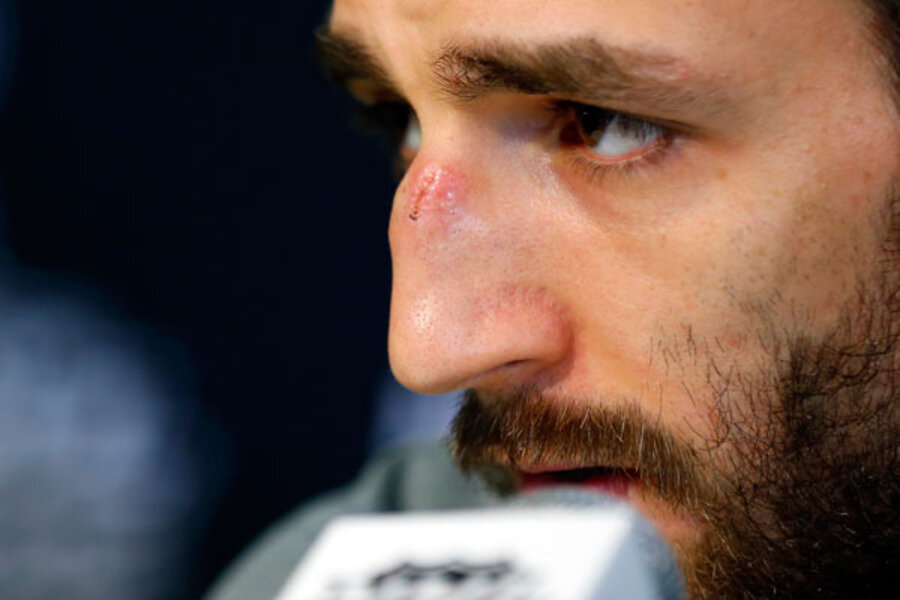Blackhawks-Bruins Stanley Cup final not for the faint of heart
Loading...
| Boston
It is possible, one might even say probable, that when the handshakes come after the end of the Stanley Cup finals – whenever that might be – the Chicago Blackhawks and Boston Bruins might genuinely respect the players across from them.
After all, when that handshake line forms, each team will feel as if it is looking into a mirror.
The Blackhawks might have the more talented forwards. The Bruins might have the better goaltender. But both teams, at their core, are about lunch pail hockey. Every night, they come to the arena, strap on their helmets, and battle for every square inch of ice.
Get ready for a 200-foot war.
This, of course, is what the Bruins are known for. With their Stanley Cup win in 2011, they brought wide-body hockey back to the National Hockey League. By the end of that 2011 finals, their opponents, the Vancouver Canucks, looked as though they'd been run through a trash compactor. Seven times.
The Bruins' largest player, the 6-foot, 9-inch defenseman Zdeno Chara, is a condor on skates – once you enter the offensive zone, you are within his reach. The Bruins' smallest player, Brad Marchand, is known as the Little Ball of Hate. Affectionately, of course.
The Blackhawks, however, are known as something else entirely. They are one of hockey's glamour teams – they of the flowing mullet of Patrick Kane, who treats the entire game like an audition for the shootout competition, and Patrick Sharp, and Marian Hossa, and ... the list goes on.
Don't believe it.
Sure, the Blackhawks can score goals. Bunches of them, in fact. They finished the regular season with 155, second only to the Pittsburgh Penguins and 24 more than the Bruins.
But that is not who they are.
Like the Bruins – and last year's Stanley Cup-champion Los Angeles Kings – they are built from the back forward. That means they have a deep corps of defenseman who are more than speed bumps in shoulder pads. They can skate, they can pass, and, yes, they can even score.
At a time in hockey history when just getting the puck out of your own zone has become a feat worthy of fireworks and a marching band, mobile defensemen who can move the puck have become the second box that any serious Stanley Cup contender must check off (after having a top goaltender). In Duncan Keith and Brent Seabrook, the Blackhawks have two of the best in the game.
And the Blackhawk defensemen are not alone in doing the defending. While the Blackhawks' forward corps is more offensively explosive than Boston's, in many ways, they look a lot like the Bruins. They are as much about keeping the puck out of their own net as putting it in the other one.
There is Jonathan Toews, who, like Bruin Patrice Bergeron, is a finalist for the Selke award – given to hockey's best defensive forward. In the previous round, Bergeron made Penguin Sidney Crosby, arguably the best player in the world, look like someone who had lost his car keys. Now the Bruins will get the same treatment in reverse.
Then there is Dave Bolland, who, like Bruin Shawn Thornton, is not enjoying himself if he's not scraping someone against the end boards. Or perhaps putting his sweaty glove in someone's face.
The list goes on. Hulking Bryan Bickell is the Blackhawks' answer to Bruin Milan Lucic. And Blackhawk Andrew Shaw, whose job is to be so annoying that everyone on the opposing team wants to punch him in the face, gushes about the Bruins' Marchand.
"I’ve always looked up to him and admired him. It’s going to be great to actually play against him once," Shaw said at a media conference.
He might be the only human ever to have uttered those words.
Even the teams' pretty-boy goal-scorers – Kane and Bruin Tyler Seguin – played together on a team in Switzerland during the NHL lockout last year.
"It was a lot of fun," Seguin told ESPN. "I got to know him. He’s a good guy. Obviously playing with someone that has that much talent and skill is definitely something you’re going to remember."
The conventional wisdom is that this is going to be a classic series. The fact that every pundit is picking the series to go six or seven games means none of them has any idea who's going to win. And how could they?
The Blackhawks feast on opponents' mistakes, transitioning from defense to offense with a speed that leaves many teams trailing haplessly in their wake. But since Round 1, the Bruins aren't making any mistakes. They play Hockey 101 – dump, chase, hit, repeat – and they have been playing it flawlessly.
The Bruins send opponents into spirals of despair when it becomes apparent that it is nearly impossible to score on them. Yet the Blackhawks actually gave up fewer goals than the Bruins in the regular season – and have allowed fewer goals per game than the Bruins in the playoffs, too. They're perfectly happy to play meat-grinder hockey, thank you.
And that's good. Because that's what they're likely to get.








